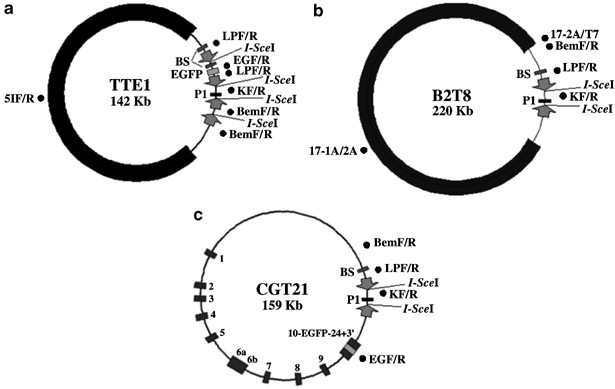
Bacterial transfer of large functional genomic DNA into human cells
- Select a language for the TTS:
- UK English Female
- UK English Male
- US English Female
- US English Male
- Australian Female
- Australian Male
- Language selected: (auto detect) - EN
Play all audios:
Efficient transfer of chromosome-based vectors into mammalian cells is difficult, mostly due to their large size. Using a genetically engineered invasive Escherichia coli vector, alpha
satellite DNA cloned in P1-based artificial chromosome was stably delivered into the HT1080 cell line and efficiently generated human artificial chromosomes de novo. Similarly, a large
genomic cystic fibrosis transmembrane conductance regulator (CFTR) construct of 160 kb containing a portion of the CFTR gene was stably propagated in the bacterial vector and transferred
into HT1080 cells where it was transcribed, and correctly spliced, indicating transfer of an intact and functional locus of at least 80 kb. These results demonstrate that bacteria allow the
cloning, propagation and transfer of large intact and functional genomic DNA fragments and their subsequent direct delivery into cells for functional analysis. Such an approach opens new
perspectives for gene therapy.
This work was supported in part by two grants from l'association Vaincre la Mucoviscidose in 2002–2003 and 2003–2004, the latter together with the German Association Mukoviszidose e.v. D
Schindelhauer was supported by the Deutsche Forschung Gemeinschaft and MD Amaral by research Grant POCTI / 1999 / MGI / 35737 from FCT Portugal. AS Ramalho was a recipient of PhD fellowship
SFRH / BD / 3085 / 2000 from FCT, Portugal. We thank C Klein and M Speicher for FISH equipment.
A Laner and S Goussard: These authors contributed equally to this work
Department of Medical Genetics, Childrens Hospital, Ludwig Maximilians University, Munich, Germany
Unité des Agents Antibactériens, Institut Pasteur, Paris, France
Centre of Human Genetics, National Institute of Health Dr Ricardo Jorge, Lisboa, Portugal
Department of Chemistry and Biochemistry, Faculty of Sciences, University of Lisboa, Lisboa, Portugal
Institute of Human Genetics, Technical University, Munich, Germany
Livestock Biotechnology, Life Sciences Center Weihenstephan, Freising, Germany
Anyone you share the following link with will be able to read this content: